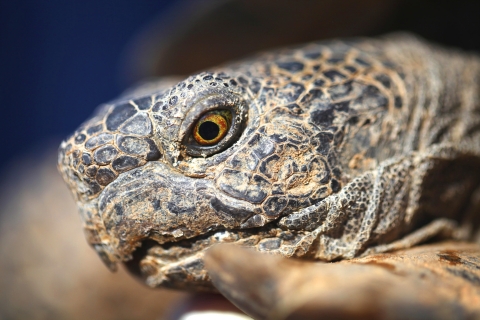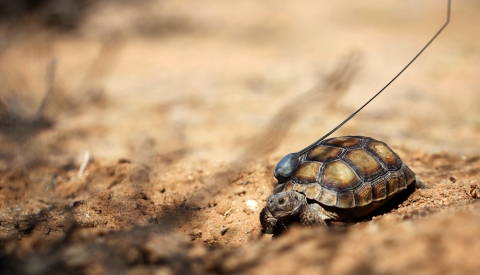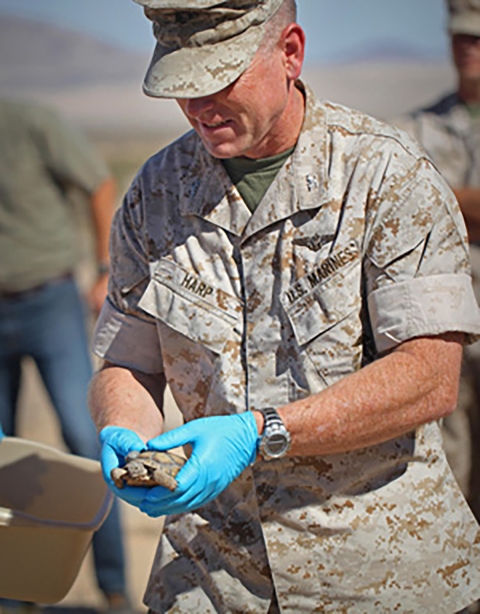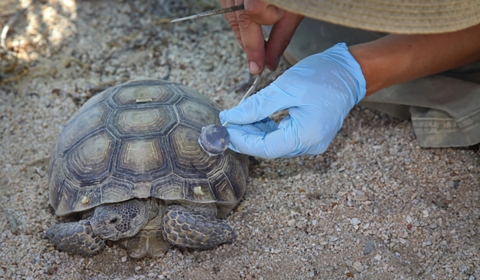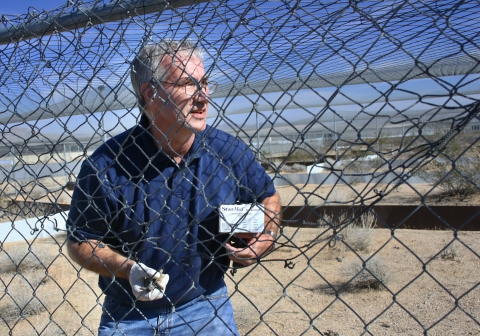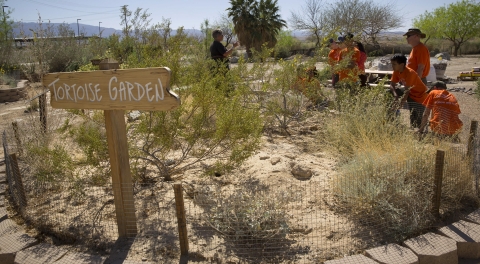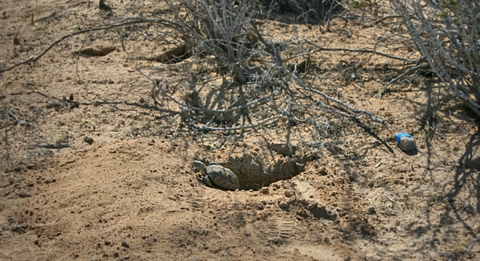Somewhere in the Mojave Desert there’s a cohort of young desert tortoises that received a head start to adulthood thanks to an innovative rearing program operated by the United States Marine Corps. In September 2015, nine years after hatching at the Marine Corps Air Ground Combat Center in Twentynine Palms, California, 35 juvenile tortoises were “discharged” from the facility they’d called home since birth to find their way in the wild. And, scientists say, most are doing just fine.
The tortoises were reared by biologists from the Combat Center’s Natural Resources and Environmental Affairs Division at a special facility called the Tortoise Research and Captive Rearing Site (TRCRS). The facility raised and released its first cohort of 35 tortoises in mid-September and is housing more than 400 additional tortoises for release in the future.
The desert tortoise is listed as a threatened species under the Endangered Species Act. Tortoise numbers in the wild have declined rapidly over the past few decades due to predation and upper respiratory disease. Soft shells make young tortoises particularly vulnerable to predators ranging from ants and ground squirrels to ravens and coyotes.
The facility contributes to tortoise conservation by providing newly hatched tortoises protection from disease and dangers they face early in life such as threats from native fire ants (Solenopsis xyloni) that prey upon tortoise eggs and juveniles. Biologists also ensure adequate vegetation is available for juveniles.
The Headstart program benefits the imperiled desert tortoise as well as Marine commanders that conduct combat training across the Center’s 900-plus square miles of desert training areas.
“As stewards of the environment, the Combat Center and the Marines Corps are dedicated to manage our natural resources in an effort to mitigate our actions as we train to be a force in readiness,” said Lt. Col. Timothy Pochop, director of the base’s Natural Resources and Environmental Affairs Division. “The opportunity at the Combat Center’s Tortoise Research and Captive Rearing Site marries perfectly with that goal.”
For the U.S. Fish and Wildlife Service, the Headstart progam is one of many significant actions being taken by the armed services to conserve and contribute to recovering desert tortoises and other species on military lands.
“Nationwide, the Armed Forces are great partners in the campaign to halt the decline of imperiled species, “said Dr. Ren Lohoefener, regional director of the Service’s Pacific Southwest Region. “The actions being taken by the Combat Center and the Corps exemplify the emphasis that is placed on species conservation being a part of the mission.”
Since the program began in 2006, Combat Center biologists at the facility have achieved almost a 96 percent annual survivorship rate. This is in sharp contrast to survivorship in the wild, where juvenile tortoises face predation by ravens, native fire ants and other species. Natural stressors, such as extended drought, also claim tortoises. A female adult tortoise lays an average of seven eggs each year. Less than 5 percent of those reach adulthood.
Because larger tortoises are less vulnerable to predation, the first cohort of tortoises was not released until they measured between 4 to 5.5 inches, about the size of a grapefruit. All are outfitted with small radio transmitters enabling scientists to track their movements.
Dr. Ken Nagy and researchers from the University of California, Los Angeles, are conducting an intensive monitoring effort that, so far, has shown favorable results. Since their release, 31 of the 35 tortoises are known to be alive in the wild. Two are missing, possibly due to transmitter failure and may be alive. Only two have been confirmed to have been killed by predators.
Over time, researchers will initiate monitoring of the reproductive status of the animals through behavioral observations (e.g., mating behavior observed), and egg production will be measured using ultrasonography and X-ray radiography. These observations will be combined with population surveys to ascertain the contribution of the head-started animals to the overall population.
“Head-starting for tortoises affords an opportunity for scientific research aimed at improving tortoise conservation efforts aboard the base and across the entire range of the desert tortoise,” said Lt. Col. Pochop. Lohoefener noted that “tortoises rangewide are in a period of decline and science like that being supported by the Corps is essential to desert tortoise recovery.”
Dr. Brian Henen, the lead biologist for the Combat Center’s tortoise program believes head-starting may become one of the many tools critical to conserving this iconic species and its habitat.
“I want the Headstart program to meets its fundamental purpose which is to establish an effective means of stabilizing and bolstering populations and helping to stem the species’ decline,” said Henen, who has been with the program since its inception.
Henen said the facility was created in 2006 through a joint venture with UCLA, who also helped build similar facilities in California at the U.S. Army’s Fort Irwin National Training Center near Barstow, and at Edwards Air Force Base near Lancaster.
By sustaining and bolstering the population of tortoises at the Combat Center, the Marine Corps hopes to help the desert tortoise on its road to recovery. With more than 400 tortoises of varying ages remaining at TRCRS, additional releases will be occurring for the next 10 years. Information obtained through the monitoring of the tortoise releases will shed additional light on the species’ life history.

